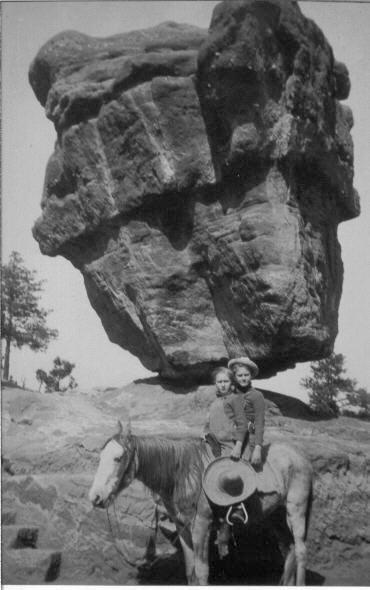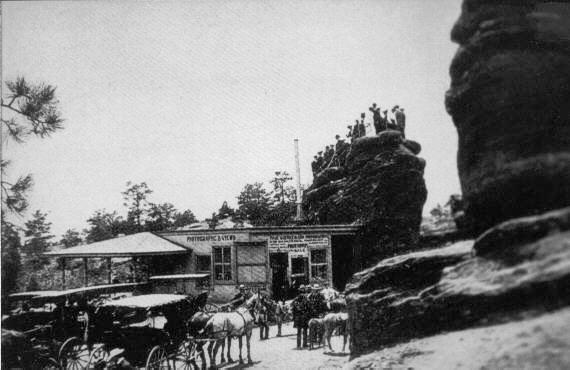
Old-time tour drivers often told unsuspecting touists that Balanced Rock rotated on its axis once a year; should they come back the following year they would see an entirely different face of the rock. Area children, for their part, often placed empty coke bottle under the bottom of the rock before a windstorm. On their return, they would find the bottle shattered to pieces. This practice came to an end at mid-century after a group of college students attempted to topple the rock, and the city park department was forced to add a stabilizing layer of cement around the base of the rock.
Balanced Rock did not become a part of the Garden of the Gods Park until the early 1930's. Before that it was private property. During the 1890's a youngster of fourteen named Curt Goerke began taking photographs of visitors to the rock for a quarter of a dollar each. Soon he was making so much money that his father Paul quit his job, learning photography, and bought Balanced Rock and nearby Mushroom Park for $400. By the first decade of the twentieth century, the pair were taking pictures of tourists - often seating them atop the four burros kept nearby. The wet plates were developed in the Goerke Photography Shop attached to nearby Steamboat Rock. As business improved, stairs were cut into Steamboat Rock, and a telescope installed on the top.
After the Kodak camera came into popular use, the younger Goerke felt compelled to discourage free picture taking by building a high board fence around Balanced Rock and charging two-bits admission. He also plastered advertsing signs along the neighboring road from Manitou. Neighbors began writing angry letters to the local newspapers, complaining of commercialism. Eventually the letter-writers won out, and Curt Goerke sold his land to the Colorado Springs Park Department for $25,000.
In February of 1932 the Goerke fence surrounding Balancd Rock was torn. Then began the work of restoring the site to its native state. Months later, the public was invited to see the restoration, with a general invitation published in the Colorado Springs Gazette:
"The invitation is issued by G. Hennenhofer, superintendent of the city park department, and is not intended as a joke.
"Yesterday Mr. Hennenhofer and a crew of the park department completed the demolition of all the buildings, fences, shack, lean-tos and sign boards which have marred, concealed or made difficlt of access one of the most beauiful scenic areas in this region or any other - the west Garden of the Gods.
"The work of restoring the park to its native state was started last January when the city of Colorado Springs formally acquired ownrship after payment of $25,000 to its private owner. The first act was the destruction of the unsightly board fence around the Balanced Rock, most famous scenic attration in the area, during a jubilee celebration attended by thousands of citizens and representatives of the city and town governments of Colorado Springs and Manitou...
"Since May 1 the park department has been busy restoring the new area to its natural state. Fences that separated disputed boundary lines of private and public land and made a confusing maze of the roads leading to the various attractions were removed. The unsightly store defacing the side of Steamboat Rock was completely torn down. The yellow booths from where hawkers shouted at passing motorists and exhorted them, at the price of a quarter a head, to view the 'privately owned' attractions, were hauled away to be broken into kindling wood.
Glaring sign boards with their Coney island claims of wonders to be seen at the price of quarter were rooted up.
"There were seven or eight structures which were torn down. Dozens of signs and two or three miles of fences were removed.
"The work is completed with the exception of filling in the hole underneath the Steamboat Rock curio store and building an attractive iron stairway, if the park commission decides it would be desireable, to give access to the telescope on top of Steamboat Rock...."

"Residents of the Pikes Peak region are invited today to 'see the Garden of the Gods.'
